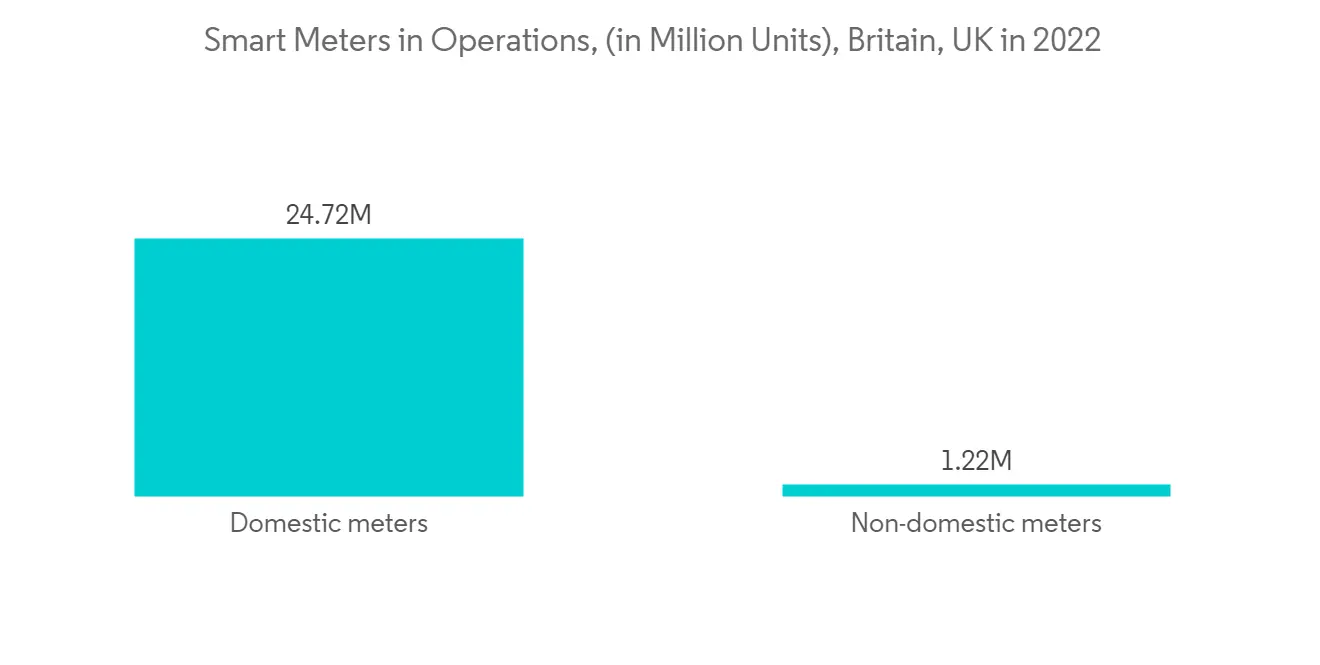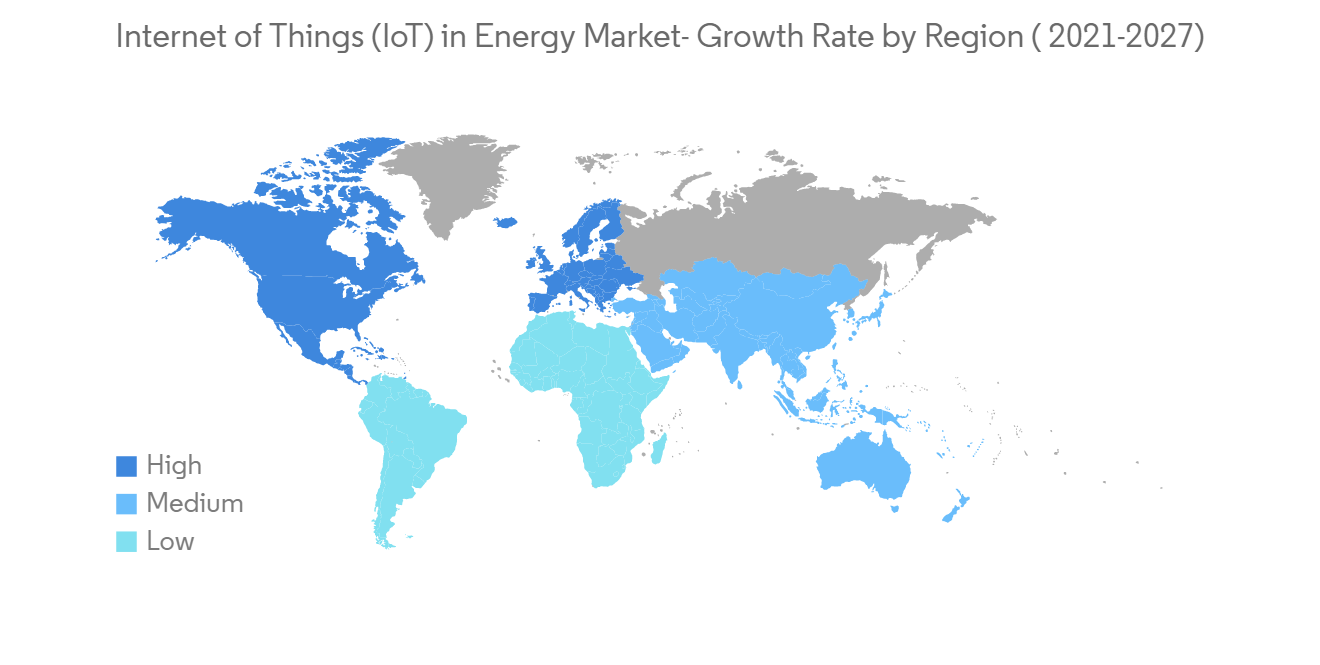 |
市场调查报告书
商品编码
1273370
能源市场中的物联网 - 增长、趋势和预测 (2023-2028)Internet of Things in Energy Market - Growth, Trends, and Forecasts (2023 - 2028) |
||||||
※ 本网页内容可能与最新版本有所差异。详细情况请与我们联繫。
在预测期内,能源物联网预计将继续以 10% 的复合年增长率增长。
根据国际能源署的说法,作为现代生活的关键推动因素,能源部门对全球和国家的应对和恢復工作也至关重要,儘管它受到了 COVID-19 大流行的严重影响。我认为是这样。
主要亮点
- 物联网 (IoT) 预计将对能源行业产生重大影响。从使用传感器的室温监控到控制整个建筑物能源使用的复杂应用,物联网可以帮助降低成本。
- 组织可以独立监控机械、照明、供暖和空调系统等设备。分析来自 IoT 设备的数据并製定策略以提高效率。物联网解决方案还有助于系统的远程控制和协调,以确保尽可能高的能源生产效率。
- 随着产生能源的自然资源日益减少和能源浪费不断增加,减少能源浪费的创新解决方案和采用可提供高效率的解决方案在世界范围内受到越来越多的关注。
- 预测分析网络监控来自嵌入电网的传感器的数据。因此,机器可以减少能量传输和分配损失,从而使能源消耗在全球范围内变得高效且具有成本效益。
- Nexus Solutions 等公司提供监控和减少建筑能耗的互联解决方案。Aquicore 还在开发一个连接到已安装的电能表的分析平台,使组织能够做出提高员工生产力和减少能源浪费的决策。
- 然而,将新的可持续分布式能源 (DER) 整合到旨在分配集中产生的能源的现有电网中是一项重大挑战。
- 从支持室温监测的传感器到远程管理能源使用,物联网在大流行期间使能源部门受益,实现了可持续发展和成本节约。此外,儘管政府出于对员工安全的担忧而关闭,但一些物联网系统已经实现了可再生能源的使用,减少了污染并使用了不可再生资源。公司得以继续运营。在大流行期间,该行业的公司已经为他们的大部分业务启用了物联网远程工作。
物联网能源市场趋势
智能电錶有望占据较大份额
- 近年来,智能电錶一直是公用事业公司采用最多的物联网设备之一。这些设备将建筑物与智能电网互连,使这些公司能够更有效地管理能源流动。智能城市也在使用智能电錶。
- 支持物联网的智能仪表使企业能够访问丰富的实时数据,以降低成本、提供更好的服务并增加利润。它还有助于有效平衡电力负载、最大限度地减少停电、通过更准确的预测实现更高效的能源分配,以及根据实时需求提高或降低成本来实现动态定价。
- 通过升级智能电錶和电网,许多政府也在寻求利用物联网来推动各地区绿色能源生产的增长。例如,美国能源部正在寻求能够促进绿色能源使用,同时大幅降低成本的智能电网。这些因素促使能源公司投资物联网技术以跟上其他人的步伐。
- 智能计量技术使公用事业公司能够使用来自智能仪表的准确实时数据提供有用和详细的能源消耗反馈,提高每月能源账单的透明度,并根据使用情况提供准确的账单。您还可以让您的客户做出更明智的决策他们的能源使用,例如定价。这些优势正在推动市场的增长。

北美将实现最高增长
- 随着物联网在该领域发挥更大作用,预计北美将成为智能能源项目部署驱动的重要市场。此外,整个行业的快速数字化和技术进步正在推动该地区物联网的发展。
- 美国和加拿大是大数据、物联网和移动等技术的早期采用者,为物联网市场创造了巨大的增长机会。这些国家建立了强有力支持研发活动投资的经济体系。此外,与其他地区相比,该地区的创业文化发展更快。
- 此外,该地区拥有强大的物联网供应商立足点,为市场增长做出了贡献。其中包括IBM Corporation、Microsoft Corporation、Intel Corporation、Cisco Systems Inc.、Google Inc.等。
- 加拿大的製造业依靠创新和技术投资来保持竞争力。在投入和劳动力成本不断上升,以及来自全球主要製造商的竞争的环境下,这里的公司有望投资于物联网等技术,以保持竞争力并保持营业利润率的增长。随着 5G 网络的出现,美国立法者正在引入 "物联网准备法案" ,以应对物联网的大规模增长。
- 与美国相比,加拿大企业在前一年采用先进技术方面落后了。北美小型企业先进製造业调查。加拿大的能源部门正在采购联网传感器,以监控发电厂、电网和智能家居仪表的各种活动。

能源物联网概述
能源中的物联网是零碎的。减少能源浪费和提高成本效益意识在工业机器人市场创造了有利可图的机会。总体而言,现有竞争对手之间的敌意很高。预计将收购专注于创新和与初创企业合作的大公司。
2022 年 3 月,Intel公司宣布达成协议,收购总部位于以色列的 Granulate Cloud Solutions Ltd。Granulate Cloud Solutions Ltd 创建用于持续实时优化的软件。云和数据中心客户可以通过提高计算工作负载的性能并降低基础设施和云成本,从收购 Granulate 中获益。
2022 年 3 月,SAP SE 收购了 Taulia。此次收购加强了 SAP 向 CFO 办公室提供的服务并扩展了其业务网络。Taulia 的产品将继续与 SAP 软件完全集成并单独提供。在 SAP 集团内,Taulia 将作为一家独立公司以其品牌运营。
2022 年 2 月,Intel收购了工业 Linux 的 PREEMPT RT(实时)架构师和技术提供商 Linutronix。随着Intel软件生态系统的发展,此次收购反映了Intel对支持 Linux 内核和 Linux 社区的承诺。
其他福利:
- Excel 格式的市场预测 (ME) 表
- 3 个月的分析师支持
目录
第 1 章 简介
- 研究假设和市场定义
- 本次调查范围
第二章研究方法论
第三章执行摘要
第四章市场动态
- 市场概况
- 工业吸引力——波特五力分析
- 新进入者的威胁
- 买方/消费者议价能力
- 供应商的议价能力
- 替代品的威胁
- 竞争对手之间的竞争
- 行业价值链分析
- 评估 COVID-19 对行业的影响
- 市场驱动力
- 能源消耗控制意识增强
- 市场製约因素
- 与数据相关的高风险
第五章市场细分
- 类型
- 硬件
- 智能恆温器
- 智能电錶
- 电动汽车充电站
- 其他硬件
- 物联网软件
- 物联网平台
- 物联网安全
- 物联网服务
- 硬件
- 区域
- 北美
- 欧洲
- 亚太地区
- 拉丁美洲
- 中东/非洲
第六章竞争格局
- 公司简介
- AGT International
- Carriots SL
- Cisco Systems Inc.
- Davra Networks
- Flutura Business Solutions LLC
- IBM Corporation
- Intel Corporation
- Maven Systems Private Limited
- SAP SE
- Wind River Systems Inc.
第七章投资分析
第八章市场潜力
The Internet of Things in the energy market is expected to witness a CAGR of 10% over the forecast period. According to the International Energy Agency, as a critical enabler of modern life, the energy sector, despite being significantly affected by the COVID-19 pandemic, is also essential for global and national response and recovery efforts.
Key Highlights
- The Internet of Things (IoT) is expected to impact the energy sector significantly. From monitoring the temperature of a room using sensors to complex applications that control the energy use of an entire building, IoT helps in cost-cutting.
- Organizations can independently monitor their equipment, including machinery, lighting, heating, and air conditioning systems. IoT device data is analyzed to develop strategies for increasing efficiency. IoT solutions also assist in remotely controlling and regulating systems to establish the highest possible energy production efficiency.
- The decreasing natural resources that produce energy and the increasing wastage of energy have drawn the attention of various nations worldwide to innovate solutions that reduce energy wastage and adopt solutions that offer high efficiency.
- A predictive analytics network monitors the data from sensors embedded in power grids. Thus, machinery can reduce energy transmission and distribution losses, making energy consumption highly efficient and cost-effective worldwide.
- Companies such as Nexus Solutions offer connected solutions to monitor and reduce energy consumption in buildings. Aquicore is also developing an analytics platform that connects to energy meters that have already been installed, enabling organizations to make decisions that improve staff productivity and reduce energy wastage.
- However, integrating new sustainable distributed energy resources (DER) into the existing grid is designed to distribute centrally generated energy, which is quite challenging.
- IoT was beneficial for the energy sector during the pandemic, from sensors that enable monitoring of room temperatures to managing energy usage from a distance, resulting in sustainable development and cost reduction. Additionally, several IoT systems made it possible to use renewable energy, reducing pollution and exploiting non-renewable resources, enabling enterprises to continue operating despite government lockdowns out of concern for employee safety. For the majority of tasks in businesses in this industry during the pandemic, IoT enabled remote working.
Internet of Things in Energy Market Trends
Smart Meters Expected to Hold Significant Share
- Smart meters have been among utility companies' most adopted IoT devices in the last few years. These devices interconnect buildings with the smart energy grid, which allows these companies to manage energy flow more effectively. Smart cities are also leveraging smart meters.
- With IoT-ready smart meters, organizations can access rich, real-time data to provide better service while reducing costs and boosting profits. Moreover, this helps effectively balance electric loads, minimize power outages, stream energy distribution through more accurate forecasting, and enable dynamic pricing by raising or lowering costs based on real-time demand.
- By upgrading to smart meters and grids, many governments are also trying to utilize IoT to facilitate localized green energy production growth. For instance, the United States Department of Energy is pursuing a smart grid that can help boost the use of green energy while driving down costs in mass. These factors also force energy companies to invest in IoT technology to keep up with everyone around them.
- With smart meter technology, utilities can also empower their customers to make smarter decisions about their energy usage by providing helpful and detailed feedback on energy consumption using precise, real-time data from their smart meter, improving transparency on monthly energy bills, accurate pricing based on usage, etc. These advantages are boosting the market growth.

North America Region to Witness the Highest Growth
- Due to IoT's growing role in the sector, North America is expected to be a prominent market driven by smart energy projects' deployment. Rapid digitalization across industry verticals and technological advancements has also fueled IoT growth in this region.
- The United States and Canada are the early adopters of technologies such as Big Data, IoT, and mobility, creating significant growth opportunities for the IoT market. These countries have established economies, which strongly empower them to invest in R&D activities. Moreover, the start-up culture in the region is growing more rapidly compared to the other areas.
- Moreover, the region has a strong foothold on IoT vendors, contributing to the market's growth. Some include IBM Corporation, Microsoft Corporation, Intel Corporation, Cisco Systems Inc., and Google Inc.
- Canadian manufacturers depend on innovation and investment in technologies to be competitive. In an environment of increasing input, labor cost, and competition from large global manufacturers, companies here are expected to invest in technologies like IoT to remain competitive and maintain their operating margins. US lawmakers have introduced the "IoT Readiness Act" for massive IoT growth with the 5G networks' arrival.
- In comparison to the United States, Canadian companies have been slower to adopt advanced technologies in the previous year. Advanced Manufacturing survey of SMEs in North America. The Canadian energy sector has been procuring internet-connected sensors to monitor various activities across generating plants, distribution networks, and smart home meters.

Internet of Things in Energy Industry Overview
The internet of things in the energy market is fragmented. The increasing awareness of energy waste control and cost-effectiveness provides lucrative opportunities in the industrial robot market. Overall, the competitive rivalry among existing competitors is high. Acquisitions and collaboration of large companies with startups are expected, focusing on innovation.
In March 2022, Intel Corporation announced an agreement to acquire Granulate Cloud Solutions Ltd, an Israel-based company. Granulate Cloud Solutions Ltd creates software for continuous real-time optimization. Customers of cloud and data centers will benefit from Granulate's acquisition by increasing compute workload performance and reducing infrastructure and cloud costs.
In March 2022, SAP SE acquired Taulia. The acquisition boosts SAP's offerings for the CFO office and broadens its business network. Taulia's products will continue to be offered separately and fully into SAP software. Within the SAP Group, Taulia will do business as an independent company with its brand.
In February 2022, Intel Acquired Linutronix, the PREEMPT RT (Real Time) architect and a technology provider for industrial Linux. With the growth of Intel's software ecosystem, this acquisition reflects Intel's commitment to supporting the Linux kernel and the Linux community.
Additional Benefits:
- The market estimate (ME) sheet in Excel format
- 3 months of analyst support
TABLE OF CONTENTS
1 INTRODUCTION
- 1.1 Study Assumptions & Market Definition
- 1.2 Scope of the Study
2 RESEARCH METHODOLOGY
3 EXECUTIVE SUMMARY
4 MARKET DYNAMICS
- 4.1 Market Overview
- 4.2 Industry Attractiveness - Porter's Five Forces Analysis
- 4.2.1 Threat of New Entrants
- 4.2.2 Bargaining Power of Buyers/Consumers
- 4.2.3 Bargaining Power of Suppliers
- 4.2.4 Threat of Substitute Products
- 4.2.5 Intensity of Competitive Rivalry
- 4.3 Industry Value Chain Analysis
- 4.4 Assessment of COVID-19 Impact on the Industry
- 4.5 Market Drivers
- 4.5.1 Increasing Awareness of Energy Consumption Control
- 4.6 Market Restraints
- 4.6.1 High Risk Associated with Data
5 MARKET SEGMENTATION
- 5.1 Type
- 5.1.1 Hardware
- 5.1.1.1 Smart Thermostats
- 5.1.1.2 Smart Meters
- 5.1.1.3 EV Charging Stations
- 5.1.1.4 Other Types of Hardware
- 5.1.2 IoT Software
- 5.1.3 IoT Platform
- 5.1.4 IoT Security
- 5.1.5 IoT Services
- 5.1.1 Hardware
- 5.2 Geography
- 5.2.1 North America
- 5.2.2 Europe
- 5.2.3 Asia Pacific
- 5.2.4 Latin America
- 5.2.5 Middle East and Africa
6 COMPETITIVE LANDSCAPE
- 6.1 Company Profiles*
- 6.1.1 AGT International
- 6.1.2 Carriots SL
- 6.1.3 Cisco Systems Inc.
- 6.1.4 Davra Networks
- 6.1.5 Flutura Business Solutions LLC
- 6.1.6 IBM Corporation
- 6.1.7 Intel Corporation
- 6.1.8 Maven Systems Private Limited
- 6.1.9 SAP SE
- 6.1.10 Wind River Systems Inc.












